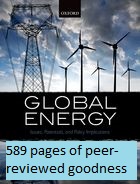Introducing the EnergyNumbers 2050 Pathways calculator
The DECC 2050 calculator is a good start at producing a toy model to give some ideas of the trade-offs, and approximate orders of magnitude of costs involved in converting Britain’s energy systems into a low-carbon system.
But it has its flaws.
So I’ve revised some of the model’s weakest parts, and re-released it. Here’s the EnergyNumbers 2050 Pathways calculator
A summary of the changes (most recent, first)
- Added a new option to change the amount of fossil-fuels (coal, gas, oil) extracted in the UK. This option exists in the DECC spreadsheet, but wasn’t previously available in the web interface.
- Added a whole new section with performance against national and international targets. In the top-left corner of every page, you’ll find indicators showing progress against targets. Click on them to read an explanation of each target, and how well the selected pathway performs against each.
- Change nuclear level 1 to phaseout by 2020; bumped all the other levels up by one (so old level 1 is new level 2; old level 3 is new level 4), and updated all the “expert” pathways accordingly. Old level 4 wasn’t plausible, wasn’t used in any of the “expert” pathways, and so has been removed
- Added estimated damage costs for greeenhouse gases: low £70/tCO2e; medium £100/tCO2e; high £200/tCO2e
- Added estimates of nuclear liability costs: low 0p/kWh; medium 11p/kWh; high 100p/kWh
- The choice of car and van techology, between fuel cells and electric batteries, is a category scale (A,B,C,D), not ascending order of difficulty (1-4)
- Ensure coal capacity has a floor of zero
- Selecting biomass plant will not drive up coal use
- Updated nuclear build costs: high £4.548/Wp rising to £5.072/Wp; medium £3.50/Wp; low £2.478/Wp
- Onshore wind, level 4 upgraded to hit 50GWp by 2020 and stay steady
- Offshore wind fixed-foundation, level 4, from 2020 onwards, upgraded to 10GWp annual installation rate

